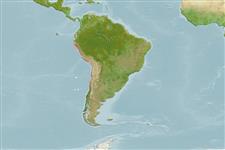Common names from other countries
Classification / Names / Names
Populärnamn | synonymer | Catalog of Fishes (gen., sp.) | ITIS | CoL | WoRMS
Environment: milieu / climate zone / depth range / distribution range
Ekologi
; djupintervall 0 - 20 m (Ref. 114693). Tropical, preferred 15°C (Ref. 107945); 5°S - 43°S, 81°W - 70°W (Ref. 114682)
Southern Pacific: From Sechura, Peru to Chiloé, Chile. Tropical and subtropical.
Length at first maturity / Size / Vikt / Age
Maturity: Lm ? range ? - ? cm Max length : 7.0 cm ShL hane/ej könsbestämd; (Ref. )
Lives in the swash zone of exposed high-energy intermediate and dissipative sandy beaches. Usually burrows to a depth of around 10 cm, but can reach 25 cm if disturbed. Adults are mainly restricted to the surf zone while most of the juveniles to the swash zone (Ref. 106909). Intertidal to subtidal (Ref. 113820).
Life cycle and mating behavior
Könsmognad | Reproduktion | Lek | Ägg | Fecundity | Larver
Members of the class Bivalvia are mostly gonochoric, some are protandric hermaphrodites. Life cycle: Embryos develop into free-swimming trocophore larvae, succeeded by the bivalve veliger, resembling a miniature clam.
SAUP Database. 2006. (Ref. 356)
IUCN Red List Status (Ref. 130435)
CITES status (Ref. 108899)
Not Evaluated
Not Evaluated
Human uses
Fiskeri: kommersiell
FAO - fiskeri: landings | FishSource | Sea Around Us
Verktyg
Ytterligare information
Age/SizeTillväxtLength-weightLength-lengthMorfologiLarverAbundans
Internet-källor
Estimates based on models
Preferred temperature
(Ref.
115969): 11.8 - 21.9, mean 17.4 (based on 30 cells).
Resiliens
Hög, lägsta populationsfördubblingstid mindre än 15 månader (K=1.13).
Vulnerability
Low vulnerability (10 of 100).
